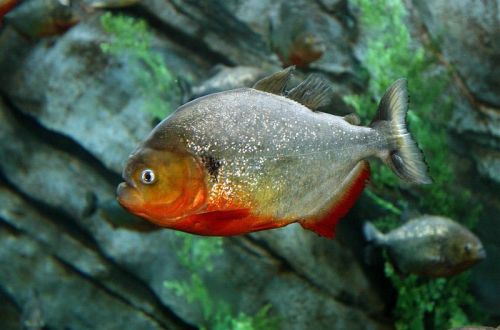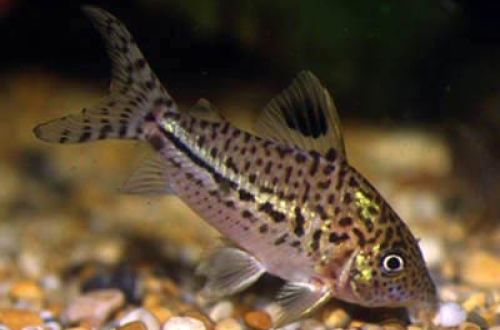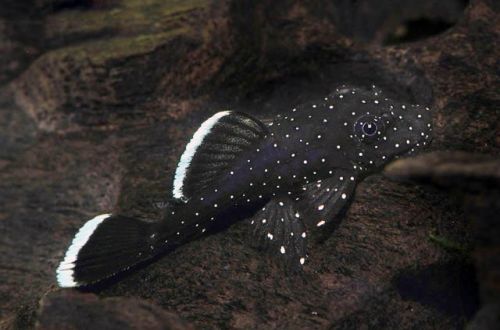
Black spot piranha
The black-dotted piranha, scientific name Pygocentrus cariba, belongs to the Serrasalmidae family. One of the most famous river predators. Despite its popularity, very few dare to maintain it due to its high cost and complexity.

Contents
Habitat
It comes from South America from the Orinoco River basin, covering vast territories of Colombia and Venezuela. The natural distribution area is almost 600 square kilometers. This species is found everywhere in the main channels of rivers, floodplain lakes, and during the annual rainy season swims into flooded areas of tropical forests.
Brief information:
- The volume of the aquarium – from 400 liters.
- Temperature – 20-28°C
- Value pH — 4.0–7.0
- Water hardness – 1–10 dGH
- Substrate type – any
- Lighting – any
- Brackish water – no
- Water movement – light or moderate
- The size of the fish is 25–35 cm.
- Food – mainly meat feed
- Temperament – aggressive
- Content – alone or in a flock
Description
Adults reach a length of 25–35 cm. Females are somewhat larger. The body is massive, oval in shape, compressed from the sides. Outwardly, it is almost identical to another related species – the Red-bellied piranha. The coloration is gray with silvery scales. At a certain angle of incidence of light, the fish can appear almost white. The abdomen, lower part of the head and anal are red. A distinctive feature is the presence of a dark spot located behind the gill cover.
Food
Often referred to as a predator, although in reality their diet is very varied and consists not only of live fish, but also aquatic invertebrates, insects, nuts, seeds and fruits. In nature, they can chase and eat weak or dying fish. Despite the legend that has developed thanks to the films, piranhas do not attack animals and people in the water, bites are extremely rare.
In a home aquarium, bloodworms, small earthworms can become the basis of the diet for young fish, adults will take pieces of fish and mussel meat, whole shrimp, larger earthworms.
Maintenance and care, arrangement of the aquarium
The optimal size of the aquarium for one fish starts from 400-500 liters. If you plan to keep a small flock, then the volumes increase many times – it’s all about the behavior, but more on that below. For the Black-dotted Piranha, the design does not matter, on the contrary, it is recommended to exclude some decorative elements. For example, live plants are more likely to be eaten and pulled out of the ground.
The quality of the water is of key importance. Since fish produce a lot of waste, a lot of pressure falls on the filtration system. You can’t do without productive external filters. In addition, it is necessary to replace part of the water with fresh water at least 30–50% of the total weekly. In large aquariums, it is advisable to connect to an automatic water change system.
Piranhas are beyond the scope of amateur aquarism, therefore, within the framework of this article, it does not describe all the details and nuances of their content. Often, specialized companies or incoming specialists are engaged in servicing an aquarium with these fish, and the owner can only enjoy his predatory pets.
Behavior and Compatibility
With the choice of neighbors there will be big problems. If piranhas are always full, then other fish will be relatively safe, provided that they are of comparable size or significantly larger. Any small fish will inevitably be considered as a source of food.
Intraspecific relationships are also not simple. Although in nature they keep in large groups, but this is rather a desire to protect themselves from other predators. In the limited space of aquariums, where there is no external danger, it is not uncommon for a stronger individual to kill a weak one. As a result, only one of the entire group can remain. It is advisable to keep only one fish, if there is a huge reservoir, it is possible to increase the number to 5–6 or more.
Breeding / breeding
At the time of writing, no breeding cases have been recorded in amateur home aquaria. Wild populations have two reproductive cycles, with the onset of the rainy season and at the end of the year in November/December. The spawning grounds are thickets of aquatic plants.
Fish diseases
It is an unpretentious and hardy fish. Health problems are associated with injuries, poor nutrition and inappropriate water composition. In the event of the appearance of signs of illness (lethargy, change in body shape, loss of appetite, etc.), it is sometimes enough to bring the conditions of detention back to normal so that the body copes with the problem. However, in some cases, medical treatment will have to be used. Read more about symptoms and treatments in the Aquarium Fish Diseases section.





